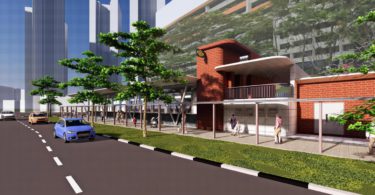Seawater intake and outfall systems are built to draw in seawater for a desalination process to produce drinkable water or to supply the water demand for cooling in onshore processes. The systems consist of an intake and outtake structure on land, and an intake and an outtake line that connects the structure and the sea. These lines are made of either reinforced concrete pipes, glass fibre reinforced pipes or box culverts.
INEFFECTIVE CONVENTIONAL METHOD
The installation of box culverts, if done conventionally, is highly ineffective. First, the stone bedding material is lifted by crane and dropped into the sea bed. The placement is often inaccurate and generates high wastage. Moreover, the bedding needs to be levelled off manually by human divers, which is time consuming and labour-intensive, as well as risky for the workers’ safety. Then, the box culverts need to be loaded using heavy machinery that consumes a lot of fuels and increases the safety hazard to marine life.
A marine engineering company, HSL Berhad, has developed and tested a technology that could transform these unsustainable, inefficient processes. Sharing the innovation in BuildTech Digital Series, the company explained how the installation mechanism—by using a bedding barge, a levelling barge and a gantry barge—can substantially reduce the carbon footprint and the need for manpower.
THE BARGE SYSTEM
The bedding barge has louvre gates that are operated by a hydraulic system that evens out the stone material dropped into the sea bed. This alone can simplify the process because the trench will not be piling up like when the material is dropped using a single-gate system. In addition to this, the barge is equipped with multi-beam echo sounder surveying system to increase the accuracy of the loading.
The levelling barge has a multi-screw leverer system that can level the stone bedding faster and more accurately compared to manual levelling by divers. The gantry crane barge with highly automated systems can also transfer the box culverts to the locations more efficiently. The counter weight rail cart will balance out the weight as the box culverts are being transferred using cargo handling rail cart. To avoid any unnecessary errors, the survey system technology prescribes the location precisely.
MANPOWER AND ENERGY SAVING
The energy consumption is cut down significantly with this innovative solution, especially in the heavy lifting stage. The overall fuel consumption per month declines almost threefold, from around 200 to 77 thousand litres. The manpower per day can be reduced from 28 to 17. The time required to finish a 100-square-metre bedding area is reduced from 10 to 5 hours and for the levelling area from 12 to 4 hours. As for the installation of 1 box culvert, the time is cut down from 8 to 4 hours. The overall operational cost to complete a project can decline from around S$998,000 to S$644,000.
Read: Construction innovation: Drain system upgrades and road expansion works without disrupting traffic
CONCLUSION
Trends in the power and water market, just like in the built environment sector, show a focus on making systems more energy efficient. A lot of attention has been paid to the operational efficiency of seawater intake and outfall systems, as well as the impact on marine life and environment.
There should be an equal amount of effort in the construction and installation process too, so that the society’s infrastructural needs and the interests of stakeholders could be met without damaging nature. The barge system has shown us how box culverts could be loaded underwater with less carbon footprint and manpower, but this is just one segment of the entire marine infrastructure construction sector. We should, therefore, expect more sustainable construction principles to be practiced not only on land but also on the seas and shores.– Anisa Pinatih, Construction+ Online
Disclaimer: Construction+ makes reasonable efforts to present accurate and reliable information on this website, but the information is not intended to provide specific advice about individual legal, business, or other matters, and it is not a substitute for readers’ independent research and evaluation of any issue. If specific legal or other expert advice is required or desired, the services of an appropriate, competent professional should be sought. Construction+ makes no representations of any kind and disclaims all expressed, implied, statutory or other warranties of any kind, including, without limitation, any warranties of accuracy and timeliness of the measures and regulations; and the completeness of the projects mentioned in the articles. All measures, regulations and projects are accurate as of the date of publication; for further information, please refer to the sources cited.
Hyperlinks are not endorsements: Construction+ is in the business of promoting the interests of its readers as a whole and does not promote or endorse references to specific products, services or third-party content providers; nor are such links or references any indication that Construction+ has received specific authorisation to provide these links or references. Rather, the links on this website to other sites are provided solely to acknowledge them as content sources and as a convenient resource to readers of Construction+.











